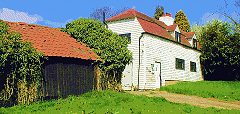|
A real village on a real hill, Noak Hill is
perched amidst rolling farmland in the far north-east corner of Greater London. When the common land here was enclosed in
1814 an area of Roman tiles ‘300 paces long’ was discovered. After enclosure, the land was bought up by the Neave
family, who also acquired most of what is now Harold Hill. Richard Neave was an eighteenth century merchant who made his fortune
from trade with the West Indies. The late seventeenth century Bear Inn, on the edge of Harold Hill, was originally called
the Goat House. The pub was acquired by Sir Thomas Neave in 1820. During the 1960s the Bear boasted a menagerie (complete
with bear) that was claimed to be the largest in the London area outside Regent’s Park.
Although within audible distance of the M25, Noak Hill retains weatherboarded and thatched cottages and the attractive red
brick church of St Thomas, built by the Neaves in 1842. Until the 1920s Noak Hill was a village of agricultural labourers
and Neave family servants but most residents now commute to work elsewhere. Having served for a while as a restaurant, the
old schoolhouse briefly reverted to educational use in the early 21st century before once again closing. To the south-east
is Dagnam Park, formerly the grounds of Dagnams, the Neaves’ mansion, which was demolished around 1952.
 |

